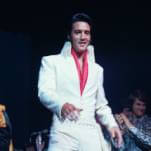Pop culture can be as forbidding as it is inviting, particularly in areas that invite geeky obsession: The more devotion a genre or series or subculture inspires, the easier it is for the uninitiated to feel like they’re on the outside looking in. But geeks aren’t born; they’re made. And sometimes it only takes the right starting point to bring newbies into various intimidatingly vast obsessions. Gateways To Geekery is our regular attempt to help those who want to be enthralled, but aren’t sure where to start. Want advice? Suggest future Gateways To Geekery topics by emailing [email protected].
Why: Haino has been in the Japanese noise scene since before there was one. He isn’t quite the king of the movement (that would be Merzbow, about whom see below), but he’s definitely the crown prince. With his trademark dark sunglasses, black clothes, custom-made guitars, and long hair, he looks every bit the rock star, but his music couldn’t be any less conventional. Since his debut more than 30 years ago, he’s been straddling the worlds of rock and jazz, and finding his comfort zone at the extremes of each. The Chiba native is a superb guitar player and a brilliant composer of free music, but his highly unconventional style—and his tendency to substitute haunting moans and strangled vocal sounds for singing—place him firmly in the noise spectrum.
Although it isn’t particularly easy to find, Haino’s work also isn’t impossible to track down. Definitely a cult figure, both at home and abroad, he’s at least well-known enough that the curious can find a few of his albums without traveling to Japan. One of his solo albums, Tenshi No Gijinka, is available as an iTunes download, although it’s a bit unusual, since it features him using only percussion instruments instead of guitar. Amazon’s mp3 store features a number of solo tracks and collaborations, as does eMusic. And if you live in a city where decent record stores still survive, you’re sure to find at least one of his records for sale. Key titles in his discography—any of which are good places to start—include A Challenge To Fate; I Said, This Is The Son Of Nihilism; Black: Implication Flooding; and the terrific live album Execration That Accept To Acknowledge.
A number of factors make Haino’s work an ideal starting point. He’s prolific, and he’s collaborated with dozens of like-minded musicians (like Tony Conrad, Derek Bailey, Peter Brotzmann, and Loren Mazzacane Connors) as well as almost everybody who’s anybody in Japanese noise, from Boris and KK Null to Boredoms and Merzbow. He’s also led two highly influential bands in the genre: the psychedelic space-rock group Lost Aaraaff and the crushing noise-rock outfit Fushitsusha, whose Allegorical Misunderstanding and Gold Blood albums are also great jumping-off points. This means that whatever direction you might want to take with Japanoise, you can get there from Haino. For another thing, he’s far too extreme to be mistaken for simply a loud-and-fast permutation of standard punk rock, but he isn’t so extreme that he’s immediately agonizing. If you can tolerate Haino, in other words, you’ll have a good idea if the genre as a whole is for you.
Next steps: The Boredoms are the obvious next step in Japanese noise. Boredoms leader Yamantaka Eye has collaborated with Keiji Haino on several occasions, usually under the guidance of like-minded American composer John Zorn, so Boredoms’ work shouldn’t be much of a leap. It’s more conventional (especially lately, as they’ve moved into a rigorous sort of psychedelic drum-circle music), and they’re much more firmly rooted in formalist Western styles. Their body of work wears American punk style as an influence far more than it does free jazz, but that also means their albums are a lot easier to find. Boredoms, like Haino, have collaborated with dozens of other artists, and their catalog will lead curious listeners in lots of rewarding directions. Those who appreciate the more structured, melodic nature of some of their work may be drawn to more straightforward acts like Melt-Banana, while fans of the edgier, noisier aspects of the band might want to investigate the ultra-heavy Boris, the punk throwbacks in Guitar Wolf, or the hyper-aggressive Zeni Geva.
If, however, the less conventional aspects of Haino’s work hook you, Boredoms might not be the logical next step; instead, try investigating some Japanoise acts that are more influenced by the free-jazz and progressive elements of his work. The place to start here is with Tatsuya Yoshida’s zeuhl-prog outfit Ruins, which is equally influenced by Haino and Christian Vander’s Magma. Other artists diverging in this direction are the free-improv band Hijokaidan, the psychedelic Astro, and the eclectic Violent Onsen Geisha.
Where not to start: Masami Akita, better known as Merzbow, is the undisputed champion of Japanese noise music, but he can’t be approached without a little preparation. His harsh, devastating music is noise in the purest sense: It’s often little more than pulverizing industrial sounds that resemble scrap metal being thrown into a jet engine. Add to this his obsession with bondage and severe sexual themes, and Merzbow should be considered advanced coursework only. (The same goes for Merzbow-lite artists like Incapacitants and Masonna.) A few of the more conceptual Japanoise performers, like sound-sculptor Aube and guitar-shredder Solmania, are rewarding, but atypical enough to not be a good starting point. And the more bizarre fringe acts, such as The Gerogerigegege (expert purveyors of “senzuri,” or “masturbation rock”), are best left to hardcore fetishists. Their stuff is hard to track down, and that’s probably for the best.





![HBO teases new Euphoria, Larry David, and much more in 2026 sizzle reel [Updated]](https://img.pastemagazine.com/wp-content/avuploads/2025/12/12100344/MixCollage-12-Dec-2025-09-56-AM-9137.jpg)


































